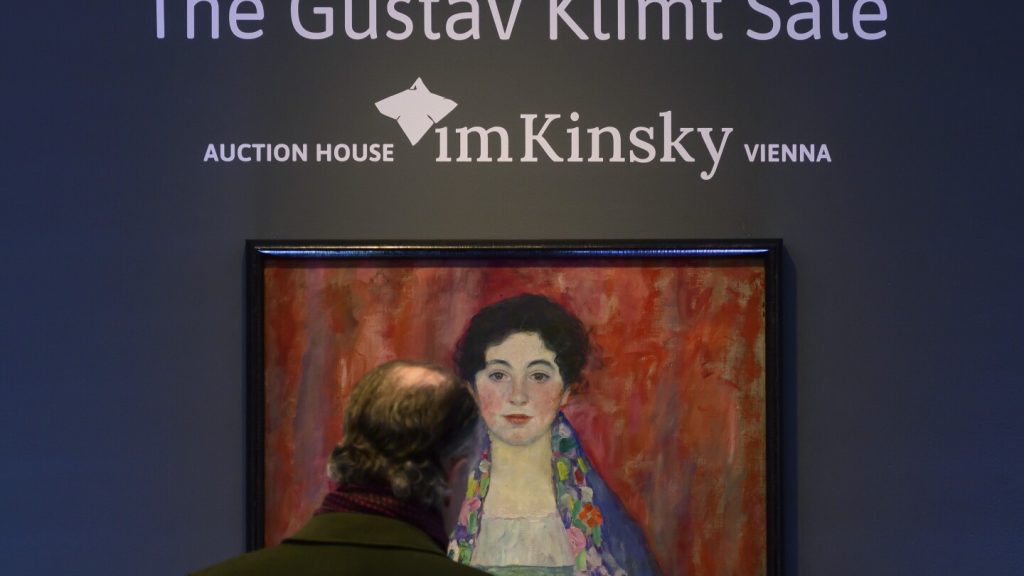A portrait by Austrian artist Gustav Klimt, believed to be lost for decades, was sold at an auction in Vienna for 30 million euros. Titled “Portrait of Fräulein Lieser,” the painting is one of Klimt’s last works, started in 1917 before his death in 1918. The auction began at 28 million euros and ended within the expected range of 30-50 million euros. The painting was purchased by a bidder from Hong Kong, although their identity was not disclosed. The auction house, Im Kinsky, described it as a rare and artistically significant piece not seen in Central Europe for years.
The painting was auctioned on behalf of Austrian private citizens and legal heirs of Adolf and Henriette Lieser, who are believed to have commissioned the portrait. It is uncertain which Lieser family member served as the model for the painting as Klimt left it incomplete in his studio before his death. The Lieser family, who were Jewish, left Austria in the 1930s and lost most of their belongings. The whereabouts of the painting during the 1925-1960 period, including the Nazi dictatorship, remain unclear. While there is no evidence that the painting was confiscated during the Nazi annexation of Austria, the uncertainty prompted an agreement between the current owners, the Lieser heirs, and the auction house under the Washington Principles to proceed with the sale.
The sale price of 30 million euros set an art auction record in Austria, surpassing the previous record of over 7 million euros for a work by Frans Francken the Younger in 2010. Despite the historical uncertainties surrounding the painting’s ownership, the auction house expressed satisfaction with the outcome, citing the importance of adhering to the Washington Principles. These principles, established in 1998, aim to address issues related to the restitution of Nazi-confiscated art. The successful sale of the portrait marked a significant moment in the art market and highlighted the ongoing efforts to resolve complex ownership disputes resulting from historical events.
The “Portrait of Fräulein Lieser,” with its vibrant colors and artistic significance, captured the attention of bidders and art enthusiasts alike during the auction in Vienna. Dating back to Klimt’s final years, the painting represents a valuable part of the artist’s legacy and adds to the intrigue surrounding its provenance. The involvement of the Lieser family, their subsequent displacement, and the painting’s journey through inheritances underscore the complexities of restitution efforts for artworks with disputed ownership. The sale of the painting not only marked a milestone in Austria’s art market but also served as a reminder of the lingering impact of historical events on the art world.
The significance of the painting’s sale goes beyond its monetary value, as it sheds light on the broader issues of cultural heritage and restitution in the art world. The narrative of the “Portrait of Fräulein Lieser” reflects the intertwined histories of art, politics, and personal stories affected by upheaval and displacement. Through ongoing initiatives like the Washington Principles, efforts are being made to address the legacy of Nazi-era confiscations and ensure justice for the victims of cultural theft. The successful auction of the Klimt painting serves as a testament to the resilience of art and its ability to transcend time and adversity, resonating with audiences worldwide.
The record-breaking sale of the Klimt portrait highlights the enduring appeal of the artist’s work and the continued interest in uncovering lost treasures from the past. The painting’s journey from creation to rediscovery underscores the complexities of art restitution and the importance of transparency in dealing with disputed artworks. As the art world grapples with issues of provenance and ownership, the sale of the “Portrait of Fräulein Lieser” serves as a poignant reminder of the ongoing efforts to address historical injustices and preserve cultural heritage for future generations.


